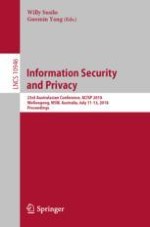2018 | OriginalPaper | Buchkapitel
A Reusable Fuzzy Extractor with Practical Storage Size: Modifying Canetti et al.’s Construction
verfasst von : Jung Hee Cheon, Jinhyuck Jeong, Dongwoo Kim, Jongchan Lee
Erschienen in: Information Security and Privacy
Aktivieren Sie unsere intelligente Suche, um passende Fachinhalte oder Patente zu finden.
Wählen Sie Textabschnitte aus um mit Künstlicher Intelligenz passenden Patente zu finden. powered by
Markieren Sie Textabschnitte, um KI-gestützt weitere passende Inhalte zu finden. powered by
